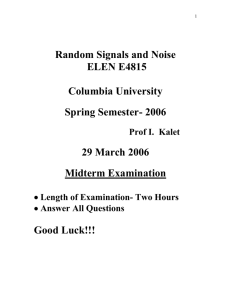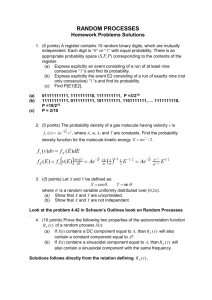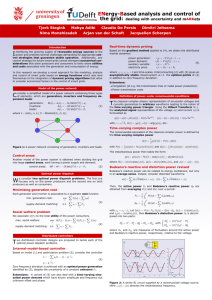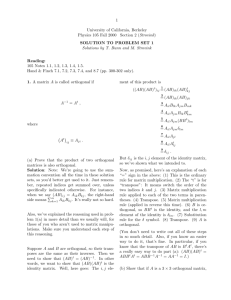For the given initial and terminal points, find the vector u in the form
advertisement
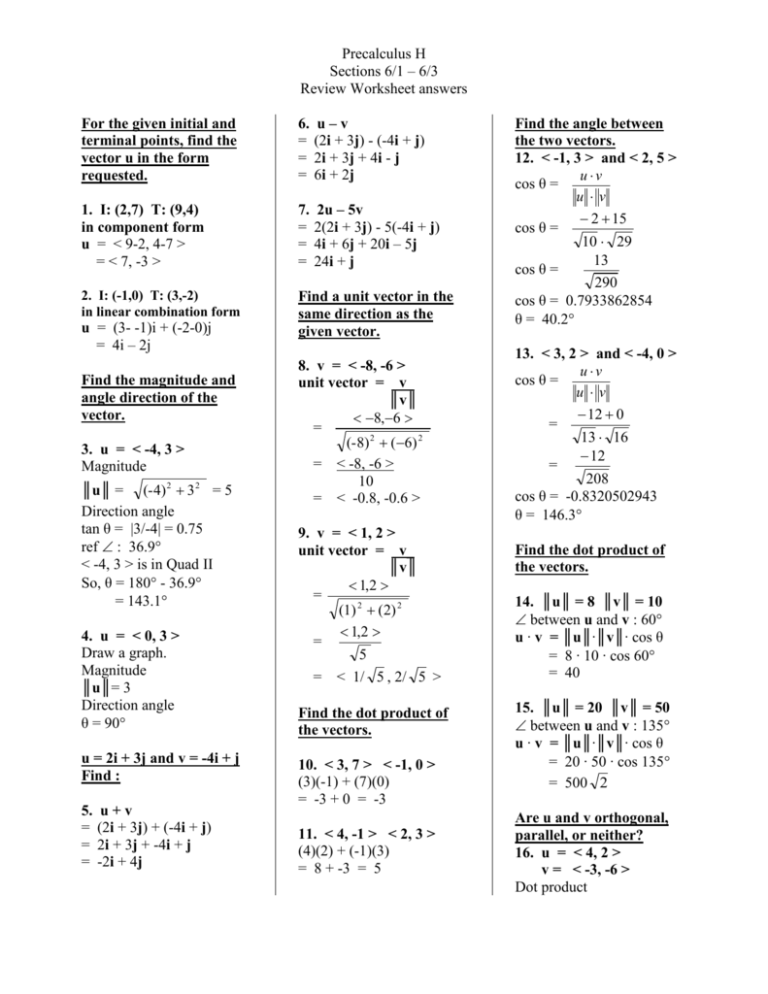
Precalculus H Sections 6/1 – 6/3 Review Worksheet answers For the given initial and terminal points, find the vector u in the form requested. 6. = = = u–v (2i + 3j) - (-4i + j) 2i + 3j + 4i - j 6i + 2j 1. I: (2,7) T: (9,4) in component form u = < 9-2, 4-7 > = < 7, -3 > 7. = = = 2u – 5v 2(2i + 3j) - 5(-4i + j) 4i + 6j + 20i – 5j 24i + j 2. I: (-1,0) T: (3,-2) in linear combination form Find a unit vector in the same direction as the given vector. u = (3- -1)i + (-2-0)j = 4i – 2j Find the magnitude and angle direction of the vector. 3. u = < -4, 3 > Magnitude ║u║ = (-4) 2 3 2 = 5 Direction angle tan θ = |3/-4| = 0.75 ref : 36.9 < -4, 3 > is in Quad II So, θ = 180 - 36.9 = 143.1 4. u = < 0, 3 > Draw a graph. Magnitude ║u║= 3 Direction angle θ = 90 u = 2i + 3j and v = -4i + j Find : 5. = = = u+v (2i + 3j) + (-4i + j) 2i + 3j + -4i + j -2i + 4j 8. v = < -8, -6 > unit vector = v_ ║v║ 8,6 = (-8) 2 (6) 2 = < -8, -6 > 10 = < -0.8, -0.6 > 9. v = < 1, 2 > unit vector = v_ ║v║ 1,2 = (1) 2 (2) 2 1,2 = 5 = < 1/ 5 , 2/ 5 > Find the dot product of the vectors. 10. < 3, 7 > < -1, 0 > (3)(-1) + (7)(0) = -3 + 0 = -3 11. < 4, -1 > < 2, 3 > (4)(2) + (-1)(3) = 8 + -3 = 5 Find the angle between the two vectors. 12. < -1, 3 > and < 2, 5 > u v cos θ = u v 2 15 cos θ = 10 29 13 cos θ = 290 cos θ = 0.7933862854 θ = 40.2 13. < 3, 2 > and < -4, 0 > u v cos θ = u v 12 0 = 13 16 12 = 208 cos θ = -0.8320502943 θ = 146.3 Find the dot product of the vectors. 14. ║u║ = 8 ║v║ = 10 between u and v : 60 u ∙ v = ║u║∙║v║∙ cos θ = 8 ∙ 10 ∙ cos 60 = 40 15. ║u║ = 20 ║v║ = 50 between u and v : 135 u ∙ v = ║u║∙║v║∙ cos θ = 20 ∙ 50 ∙ cos 135 = 500 2 Are u and v orthogonal, parallel, or neither? 16. u = < 4, 2 > v = < -3, -6 > Dot product Precalculus H Sections 6/1 – 6/3 Review Worksheet answers (4)(-3) + (2)(6) = 0 So, orthogonal. 17. u = < 5, -2 > v = < -10, 4 > Dot product (5)(-10) + (-2)(4) = -58 So, NOT orthogonal. Cross-product (5)(4) = (-2)(-10) True So, parallel 18. u = < 4, 7 > v = < -11, -6 > Dot product (4)(-11) + (7)(-6) = -86 So, NOT orthogonal. Cross-product (4)(-6) = (7)(-11) False So, NOT parallel Neither Graph the parametric system for the given domain of t. 19. x = 2t y = t+1 -2 < t < 2 t -2 -1 0 1 2 x -4 -2 0 2 4 y -1 0 1 2 3 20. x = 2cos(t) y = -4sin(t) 0<t<π t 0 4 2 3 4 π Eliminate the parameter. 22. x = t - 3 y = t2 x 4 y 0 Since x = t – 3, t = x + 3 2 2 0 2 4 Since y = t2, y = (x + 3)2 y = x2 + 6x + 9 -2 2 4 2 0 23. x = 2cos(t) y = -3sin(t) Since x = 2cos(t), cos(t) = 2x Since y = -3sin(t), cos(t) = y3 21. x = t y = t3/8 -3 < t < 3 t -3 -2 -1 0 1 2 3 x y 3 -3.375 2 -1 1 -0.125 0 0 1 0.125 2 1 3 3.375 Since sin2(t) + cos2(t) = 1, 2 2 x y 1 2 3 x2 y2 1 4 9 or 9x2 + 4y2 = 36 24. x = y = 1 t t t 1 Since x = 1 t ,t = t Since y = , t 1 y = y = y = 1 x 1 x 1 1 x 1 x x 1 x 1 1 x 1 x Precalculus H Sections 6/1 – 6/3 Review Worksheet answers 25. x = ln(t) y = t 28. y = ex or y = e x 2 29. (y+3)2 + 1 = (x-2)2 Find a parametric system for the equation. (There may be more than one correct system.) 26. y = 2x + 3 Let t = 2x. (So x = Then y = t + 3 System: x = 2t y = t+3 x4 Let t = x – 4 (So x = t + 4) Then y = 3 t System: x=t+4 y = 3t Since x = ln(t), t = ex Since y = t , y = 3 t 2 ) 27. 4y2 + 25x2 = 100 4 y 2 25 x 2 100 100 100 100 y2 x2 1 25 4 2 2 y x 1 5 2 This fits the form of sin2(t) + cos2(t) = 1 y sin( t ) Let 5 x and cos(t ) 2 System: x = 2cos(t) y = 5sin(t) This fits the form of tan2(t) + 1 = sec2(t) x - 2 = sec(t) y +1 = tan(t) System: x = 2 + sec(t) y = -1 + tan(t)



